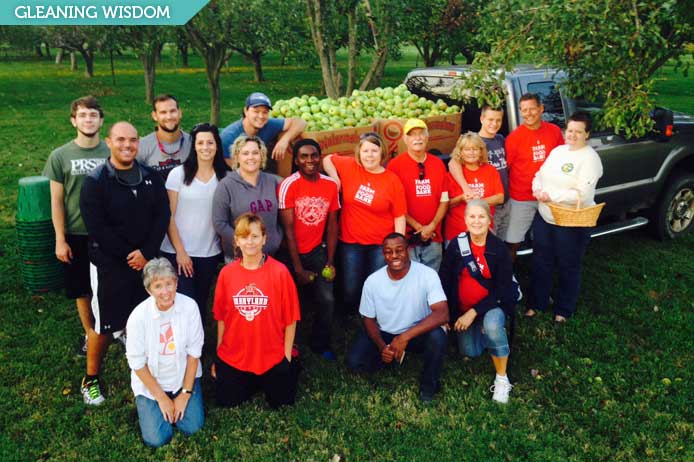Gleaning Wisdom: End of Season Notes

As the growing season begins to wind down, it’s a good time to reflect on what we’ve been able to accomplish for hungry Marylanders so far, and look ahead to what happens the rest of the year.
Each summer presents its own challenges, and Mother Nature generally has her say in things.
This growing season, the #1 challenge was the above-average amount of rainfall. In my backyard, I recall emptying the rain gauge with amounts that ranged from a few tenths all the way to 4.8″.
To a consumer, the rain may seem like a good thing. To a farmer, it depends on what he or she is growing. A grain farmer raising dry-land corn (meaning there is no source of water) welcomes a lot of precipitation while watermelon, pickling cucumber, and tomato farmers see disease and drowned plants brought on by massive amounts of rain.
It seems the only produce that made out well in the rain this season was sweet corn, as we received quite a bit of donated corn here on the Shore.
So, with Mother Nature’s unpredictability, how do we continue to provide healthy produce to people in need in Maryland?
Being a Seasoned Planner
My dad is fond of saying “prior proper planning prevents poor performance,” and thanks to the ongoing financial support of the governor and Maryland State Legislature, we can do just that.
When Mother Nature zigs and damages watermelons, the governor’s support of the Farm to Food Bank Program allows us to zag and work with our contract farmers to supply other types of produce that were not affected by weather issues.
Reasons to be Thankful During Growing Season
In addition to Governor Hogan and the Maryland State Legislature, I want to thank each of our Farm to Food Bank farm partners who have been able to contribute to this wonderful program. Each and every one of them work tirelessly to grow a quality product, and I am always so very appreciative of what they can send our way. I am also grateful to the amazing volunteers who came out to help with the gleanings, many on short notice.
I also want to thank the Poplar Hill Pre-Release Unit in Wicomico County for partnering with the Maryland Food Bank for seven growing seasons now! Volunteers and those pre-release inmates have worked together to save nearly 69,000 pounds of produce that would have gone to waste. And with apples still out there, that number will continue to rise.
A Future Farmer Gets Some Seasoning
In my Gleaning Wisdom: Midsummer Update post, I introduced you to Steven, who was attempting to grow a literal “ton of food” for his Eagle Scout Project.
I’m pleased to report that he doubled his goal, producing a total of 4,651 pounds of produce that included summer squash, tomatoes, green peppers, cantaloupe, watermelon, and eggplant. Steven’s plot was a microcosm of the challenges farmers face daily. From too much rain, heat, and weeds, to the labor needed to maintain and harvest the produce – Stephen experienced them all. He learned a lot about the daily time and effort required to raise produce.
Changing Seasons
As summer turns to fall, many of us start thinking about the holidays. For me, that means making sure that our food-insecure neighbors have access to fresh vegetables for the season.
Apples, fall squash, sweet potatoes, broccoli, and greens are expensive at the grocery store, and I know many people simply can’t afford them. Unfortunately, we don’t usually receive these types of produce as donations, so once again “proper planning” comes into play, and each year, I put aside a portion of my budget to make sure that hungry Marylanders have fresh produce for the holidays.
Tis the Season to Volunteer
Did you know that if you are employed by the State of Maryland, Governor Hogan’s “Day to Serve” proclamation gives you four hours to volunteer? But only through October 10th.
We have one opportunity—gleaning apples in Timonium on September 25—that would qualify for the Day to Serve event.
There are a few other possibilities this fall. Readers in Southern Maryland may want to contact Farming 4 Hunger, while those in Baltimore can reach out to First Fruits Farm. Both of these farms are nonprofits raising food to feed the hungry.
Planning for the 2018 Growing Season
Quite often, people ask me “What do you do for the food bank over the winter?”
Well, going back to my Dad’s “proper planning” motto, I trade in my “summer uniform” of jeans, t-shirt, and ball cap for business attire and hit the road in the winter.
I will attend as many statewide events as I can, spreading the word about this great program, looking for new partners, seeking new opportunities and keeping my fingers crossed that next year, Mother Nature is a little more supportive of our efforts to provide Marylanders in need with fresh and healthy foods…until hunger ends!
About the Author
Amy Cawley has been the coordinator of the Farm to Food Bank Program since 2010. She has a deep passion for agriculture, which fuels her efforts to make sure that every food-insecure Marylander has consistent access to nutritious, fresh produce.
Get updates on our progress in the fight against hunger
Want to see how your involvement directly impacts the well-being of your neighbors in need? Get the latest news sent to your inbox.






